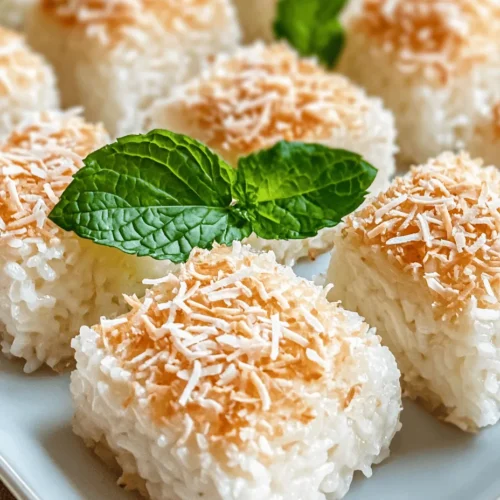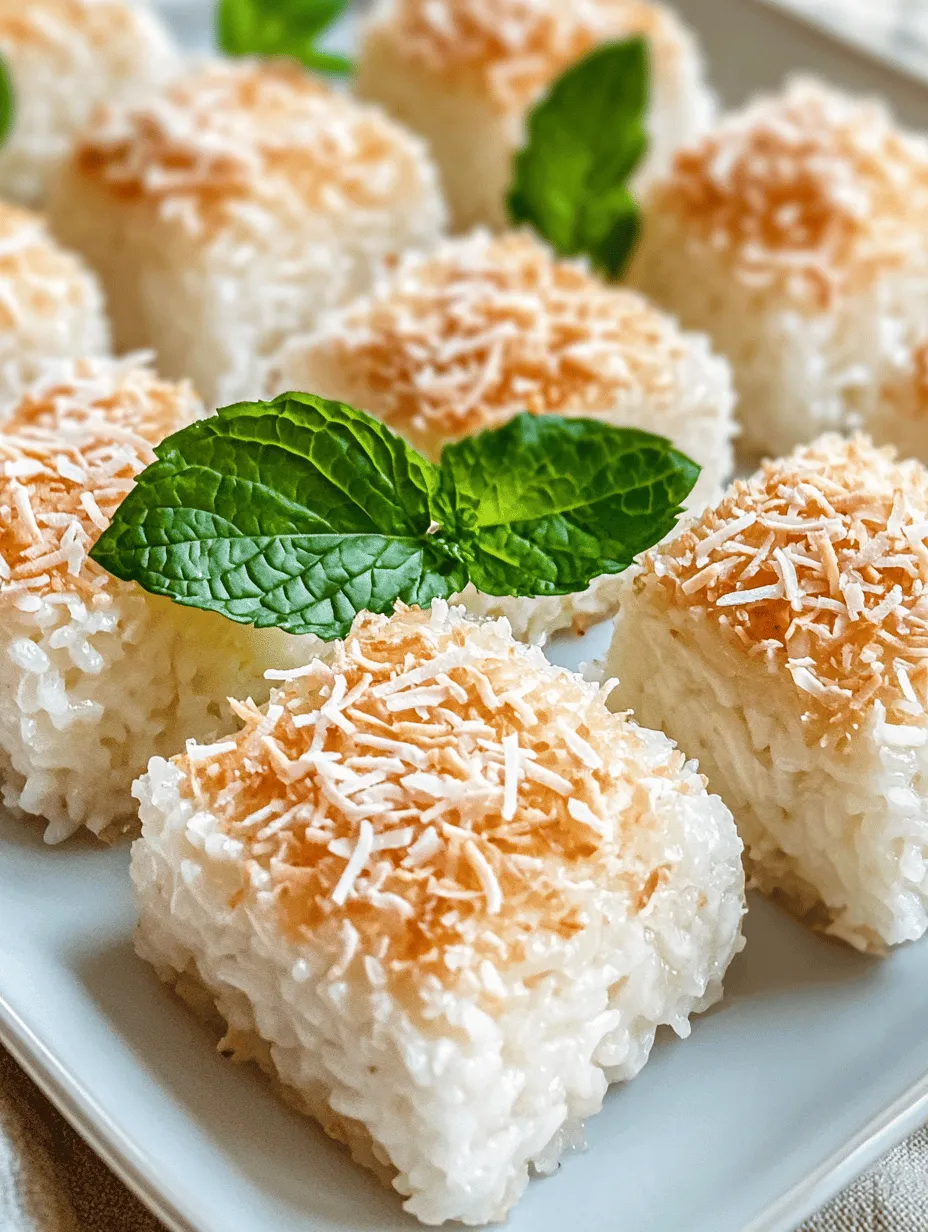Indulge in the tropical flavors of Coconut Bliss Rice Cakes, a delightful dessert that perfectly marries the creamy richness of coconut milk with the subtle sweetness of jasmine rice. These rice cakes stand out not only for their delectable taste but also for their simplicity, requiring minimal ingredients and effort while delivering maximum flavor. This makes them an ideal treat for any occasion, whether you’re hosting a dinner party or simply looking to satisfy your sweet tooth. The unique combination of textures and flavors in Coconut Bliss Rice Cakes is sure to impress anyone who takes a bite.
In this article, we will explore the origins of coconut rice cakes, the health benefits of the ingredients used, and provide a step-by-step guide to creating this delicious dish in your own kitchen. So, get ready to embark on a culinary journey that celebrates the tropical essence of coconut and the comforting nature of rice.
The Origins of Coconut Rice Cakes
Rice cakes have a rich cultural significance across various cuisines around the world. From Japan’s mochi to Italy’s torta di riso, rice cakes have been an integral part of many traditional diets. These versatile treats can be sweet or savory, and they often serve as a canvas for diverse flavors and textures. In many Asian cultures, rice cakes are associated with celebration and hospitality, often served during festivals or special occasions.
The history of coconut as a staple ingredient is equally fascinating. Native to tropical regions, the coconut palm has been a vital food source for centuries. Its versatility is unmatched; every part of the coconut can be utilized, from the meat and milk to the husk and shell. The creamy coconut milk, in particular, has found its way into a myriad of dishes, adding depth and flavor. In Southeast Asia, for example, coconut milk is frequently used in desserts, curries, and soups, showcasing its importance in culinary traditions.
Coconut rice cakes, specifically, have gained popularity in various cultures, each adapting the recipe to reflect local tastes and ingredients. In Thailand, for instance, coconut sticky rice is often enjoyed with mango, while in other regions, it may be paired with sweet syrups or fresh fruits. The adaptability of coconut rice cakes allows for endless variations, making them a beloved treat across different cultures.
Understanding the Ingredients
To create the perfect Coconut Bliss Rice Cakes, it’s essential to understand the key ingredients that contribute to its delightful flavor and texture. Let’s break down the main components of this recipe:
Jasmine Rice
Jasmine rice is a fragrant long-grain rice that hails from Thailand. It is known for its unique aroma and slightly sticky texture when cooked, making it an ideal choice for rice cakes. The floral scent of jasmine rice adds an extra layer of flavor that complements the tropical notes of coconut. Additionally, its ability to bind together when cooked ensures that the rice cakes hold their shape, providing the perfect base for this dessert.
Coconut Milk
Coconut milk is the star ingredient in this recipe, infusing the rice cakes with a creamy richness that is both comforting and indulgent. Made from the flesh of mature coconuts, this milk is rich in healthy fats and nutrients. It adds a velvety texture and a subtle sweetness to the dish. Beyond its flavor-enhancing properties, coconut milk is also known for its health benefits, including promoting heart health and providing a source of energy. It is dairy-free, making it an excellent option for those with lactose intolerance or dietary restrictions.
Sugar and Salt
Sugar plays a crucial role in balancing the flavors of Coconut Bliss Rice Cakes. A touch of sweetness enhances the natural flavor of the coconut and jasmine rice, making each bite irresistible. On the other hand, a pinch of salt is essential for bringing out the overall taste profile. Salt acts as a flavor enhancer, ensuring that the sweetness of the dish is well-rounded and not overly cloying.
Vanilla Extract
Vanilla extract is a simple yet powerful ingredient that elevates the overall taste of the rice cakes. It adds a warm, fragrant note that complements the coconut and enhances the dessert’s aromatic qualities. Using pure vanilla extract is recommended, as it provides a more authentic flavor compared to synthetic alternatives.
Shredded Coconut
Shredded coconut adds an exciting texture to the rice cakes, providing a delightful chewiness that contrasts beautifully with the creamy base. It also boosts the tropical flavor profile, making the dessert feel more indulgent. Nutritionally, shredded coconut is a good source of fiber and healthy fats, making it a wholesome addition to the dish.
Fresh Mint
While optional, fresh mint can be used as a garnish to add a burst of color and freshness to the presentation of Coconut Bliss Rice Cakes. The bright notes of mint enhance the tropical flavors and provide a visual appeal, making the dessert even more enticing.
Step-by-Step Guide to Making Coconut Bliss Rice Cakes
Now that we have a deeper understanding of the ingredients, let’s dive into the preparation process for Coconut Bliss Rice Cakes. This step-by-step guide will take you through the essential steps, ensuring that you achieve the perfect texture and flavor.
Preparation Process: From Rinsing to Mixing
Step 1: Rinse the Jasmine Rice
Begin by measuring out the jasmine rice. Rinsing the rice is a crucial step that helps to remove excess starch, which can lead to overly sticky rice cakes. Place the rice in a fine-mesh sieve or a bowl and rinse it under cold running water. Gently agitate the rice with your fingers to help release any residual starch. Continue rinsing until the water runs clear, indicating that the rice is clean. This step will ensure that your rice cakes have the ideal texture.
Step 2: Soak the Rice (Optional)
For an even softer texture, consider soaking the rinsed jasmine rice in water for about 30 minutes. This step allows the rice to absorb moisture and will yield a fluffier result once cooked. After soaking, drain the rice again before proceeding to the next step.
Step 3: Combine the Ingredients
In a medium-sized saucepan, combine the rinsed jasmine rice with coconut milk, sugar, and a pinch of salt. Stir the mixture to ensure that the rice is evenly coated with the coconut milk and that the sugar is dissolved. At this stage, you can also add the vanilla extract to infuse the mixture with its rich aroma.
Step 4: Achieve the Right Consistency
As you combine the ingredients, pay attention to the consistency of the mixture. The rice should be well-coated in the coconut milk, with a creamy texture. If it appears too thick, you can add a little bit of water or additional coconut milk to achieve the desired consistency. The mixture should be pourable but not overly liquid, as it needs to hold its shape when cooked.
Cooking Techniques: Boiling and Simmering
Step 5: Boil the Mixture
Place the saucepan over medium heat and bring the rice mixture to a gentle boil. Stir occasionally to prevent the rice from sticking to the bottom of the pan. Once the mixture starts to bubble, reduce the heat to low and cover the saucepan with a lid.
Step 6: Simmer the Rice
Allow the rice to simmer gently for about 15-20 minutes. It’s important to maintain a low temperature during this process to prevent the coconut milk from scorching. Keep an eye on the rice, and occasionally check to see if it has absorbed most of the coconut milk. The rice should be tender and fully cooked, with a creamy consistency.
Step 7: Let It Rest
Once the rice is cooked, remove the saucepan from the heat and let it sit, covered, for an additional 10 minutes. This resting period allows the flavors to meld and ensures that the rice cakes will have a delightful texture when formed.
As you embark on the journey of creating Coconut Bliss Rice Cakes, embracing the simplicity of the ingredients and the steps involved will lead to a delightful dessert that transports you to tropical paradise. In the next part of this article, we will continue with the remaining steps to form and cook the rice cakes, ensuring that you achieve the perfect balance of flavors and textures. Stay tuned!

How to Know When the Rice is Perfectly Cooked
Cooking rice to perfection is essential for creating the ideal texture in your Coconut Bliss Rice Cakes. The rice should be fluffy, tender, and fully cooked. To determine if the rice is ready, look for the following signs:
1. Texture: The rice grains should be soft but not mushy. When you bite into a grain, it should yield easily without any crunch.
2. Water Absorption: Check if the water has been absorbed completely. There should be no excess liquid remaining in the pot. If you see water, cover the pot and let it simmer for a few more minutes.
3. Aroma: A pleasant, nutty aroma should fill your kitchen, indicating that the rice is fully cooked.
4. Taste Test: If you’re unsure, the best way to check is by tasting a few grains. They should be tender and flavorful.
Once you’ve confirmed that your rice is perfectly cooked, it’s time to move on to the next step—baking the rice mixture for a delightful finish.
Baking the Rice Mixture: Achieving the Perfect Texture
The Significance of Pressing the Rice Mixture into the Baking Dish
Before placing your rice mixture in the oven, it’s crucial to compact it properly into your baking dish. Pressing down on the rice mixture serves several purposes:
– Uniform Cooking: Pressing the mixture helps ensure even cooking throughout the cake, allowing it to set properly and achieve a consistent texture.
– Stability: A well-pressed mixture will hold together better once baked, preventing the rice cakes from crumbling when sliced.
– Enhanced Flavor: Compacting the rice allows the flavors to meld more effectively, which contributes to a richer taste in the final product.
To press the mixture, use a spatula or your hands to evenly distribute it across the baking dish, ensuring that it reaches the corners and edges.
How to Monitor Baking Time for Optimal Results
Baking your Coconut Bliss Rice Cakes requires careful timing to achieve the perfect texture. Set your oven temperature to 350°F (175°C) and follow these guidelines:
– Baking Time: Bake for approximately 25 to 30 minutes. The top should turn a light golden brown, and the edges should begin to pull away from the sides of the dish.
– Checking Doneness: Insert a toothpick or knife into the center of the rice cake. If it comes out clean or with a few moist crumbs, your rice cakes are ready. If there’s wet batter, give them a few more minutes in the oven.
– Cooling: Once baked, let the rice cakes cool in the pan for about 10 minutes before transferring them to a wire rack. This allows them to set further and makes cutting easier.
Serving Suggestions and Variations
Presenting Your Coconut Bliss Rice Cakes
Once your Coconut Bliss Rice Cakes have cooled, it’s time to think about presentation. Here are some creative ideas to make your dish visually appealing:
– Garnishing: Dust the top with powdered sugar or shredded coconut for a lovely finishing touch. Fresh mint leaves can add a vibrant color contrast and a refreshing flavor.
– Serving Suggestions: Serve the rice cakes warm for a gooey texture, or let them cool completely to room temperature for a firmer bite. Both options offer a unique experience.
– Plating: Cut the rice cakes into squares or triangles and arrange them on a decorative platter. Consider pairing them with a small bowl of coconut cream for dipping.
Exploring Flavor Variations
To personalize your Coconut Bliss Rice Cakes, consider incorporating different flavors or textures:
– Coconut Variations: Use toasted coconut for a nutty crunch, or opt for sweetened coconut flakes for a richer flavor. You can also try incorporating coconut milk for a creamier consistency.
– Fruits and Nuts: Add diced mango, pineapple, or banana to the rice mixture for a fruity twist. Chopped nuts such as almonds or cashews can provide an additional layer of texture and flavor.
Health Benefits of Coconut Bliss Rice Cakes
Nutritional Analysis of Key Ingredients
Understanding the nutritional content of your Coconut Bliss Rice Cakes can help you enjoy them guilt-free. Here’s a quick overview of the key ingredients per serving:
– Calories: Approximately 150-180 calories (depending on the specific ingredients used).
– Fats: Healthy fats primarily from coconut, contributing to satisfying fullness.
– Sugars: Natural sweetness from coconut and optional sweeteners, which can be adjusted to taste.
Incorporating coconut and rice into your diet offers several health benefits:
– Coconut: Rich in medium-chain triglycerides (MCTs), coconut can provide a quick energy source and may support metabolic health.
– Rice: A great source of carbohydrates, rice serves as a filling base that can aid in energy levels throughout the day.
Balancing Indulgence with Nutritional Awareness
While Coconut Bliss Rice Cakes can be a delightful treat, they can also fit into a balanced diet. Here are some tips for making them healthier:
– Reduce Sugar: Experiment with using less sugar or substituting with natural sweeteners like honey or maple syrup.
– Use Whole Grains: Opt for brown rice instead of white rice to increase fiber content and nutritional value.
– Portion Control: Enjoy smaller servings to satisfy your sweet tooth while keeping your calorie intake in check.
Conclusion
Coconut Bliss Rice Cakes offer a delightful escape to tropical flavors with every bite. This easy-to-follow recipe permits even novice cooks to create a delicious dessert that is both satisfying and visually appealing. With a rich history and a variety of ways to enjoy it, these rice cakes are not only a treat for the taste buds but also a dish that brings people together. Embrace the joy of cooking and savor the sweet, creamy goodness of Coconut Bliss Rice Cakes in your home today. Whether enjoyed as a special dessert or a unique addition to your snack repertoire, these rice cakes are sure to become a favorite for everyone who tries them.



